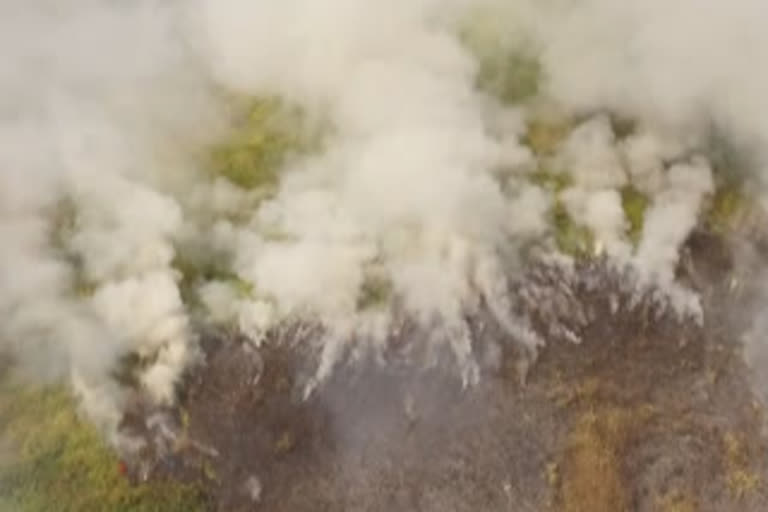Sacramento: President Donald Trump's administration has reversed course and approved a previously rejected California application for disaster relief funds to clean up damage from six recent wildfires.
Gov. Gavin Newsom said that in a statement on Friday that he had just got off the phone with Trump who just approved the major disaster declaration.
The White House earlier said that the Federal Emergency Management Agency rejected the request because it was not supported by data needed for approval.
President Donald Trump's administration this week rejected California's request for disaster relief funds aimed at cleaning up the damage from six recent wildfires among the siege of deadly and destructive blazes that have scorched the state.
The disputes surfaced as a representative of one fire-stricken area warned that time was running out to clean up debris before rain and snow arrived, bringing the threat of mudslides and toxins being washed into a river watershed.
"Democratic Gov. Gavin Newsom formally submitted a letter to the White House on Sept. 28 asking for a major disaster declaration," said Brian Ferguson, with the governor's Office of Emergency Services.
"The state plans to appeal the decision and believes we have a strong case that California's request meets the federal requirements for approval," Ferguson said in an email to The Associated Press on Friday.
The 30-page request described the disasters and pointed out that damage assessments were incomplete because the fires were still raging and access was difficult.
Read: Wildlife concerns amid second fire on Hyderabad varsity campus
White House spokesman Judd Deere said on Friday that California's request was not supported by the relevant data" needed for approval and that Trump agreed with a recommendation from the Federal Emergency Management Agency administrator.
Ferguson said that in the meantime, the state is pursuing other avenues for reimbursement and support to help individuals and communities recover. He said that the costs won't be known for some time but could be hundreds of millions of dollars.
Federal major disaster declarations allow for cost-sharing for damage, cleanup and rebuilding between the state and federal governments. They also activate relief programs led by FEMA.
Denials of relief are rare and Newsom has previously praised the Trump administration for approving aid related to the fires and the coronavirus pandemic. The White House said that Trump quickly approved wildfire relief that was supported by damage estimates.
Among the fires listed in the rejected aid application is the Creek Fire, which erupted in the Sierra Nevada on Sept. 4 and is 60% contained after burning 850 homes and more than 537 square miles (1,391 square kilometres) in Fresno and Madera counties.
Republican state Assemblyman Jim Patterson of Fresno said that he has been in consultation with area congressional offices since the denial of the aid request.
"I have gotten an encouraging response that FEMA is beginning to understand that they may have made a mistake here," he said.
Patterson said, however, there was no time to waste on bureaucratic finger-pointing and lauded the state Office of Emergency Services for pushing ahead with funding from a California disaster law in which the state will pay 75% and counties pay 25%.
Obviously, the problem is our clock is ticking and time is running out, and we're going to see rain pretty soon, snow pretty soon, he told an online briefing. If we don't get into those areas quickly we're going to miss this window and we're going to end up seeing mudslides where this toxic debris goes into the San Joaquin River watershed.
Read: Crude oil: Biden presidency likely to be a huge win for Middle East
No major new fires were reported statewide early Friday, but warnings of dangerously hot, dry and gusty conditions that can fan fires were expected to remain in effect until the evening. Nearly 9,000 firefighters remain on the lines of 21 fires.
Numerous studies have linked bigger wildfires in America to climate change from the burning of coal, oil and gas. Scientists have said climate change has made California much drier, meaning trees and other plants are more flammable.
It has been a disastrous wildfire season in California, with more than 8,500 blazes burning more than 6,400 square miles (16,000 square kilometres) since the start of the year. Thirty-one people have died and some 9,200 buildings have been destroyed.
Thousands of Northern California residents remained without electricity Friday after a utility cut off service to prevent the latest round of powerful winds from damaging equipment and sparking wildfires amid a fall heatwave.
Power restorations began Thursday afternoon and by evening Pacific Gas and Electric said about 30,000 customers were still in the dark down from about 45,000 the previous night.
"All electricity was expected to be restored by late Friday," PG&E said.
The utility better-targeted outages this time after it was criticized in 2019 for cutting power to about 800,000 customers and leaving about 2 million people in the dark for days.
Most of this year's fires have occurred since mid-August when an unusual siege of thousands of lightning strikes ignited huge blazes.
The causes of two fires that broke out in September remain under investigation. PG&E equipment is being examined in connection with the Zogg Fire in Northern California, and Southern California Edison equipment is under scrutiny in the Bobcat Fire near Los Angeles.
(AP)
ALSO READ: 'National security', 'COVID-19'- agenda for next Trump-Biden debate



